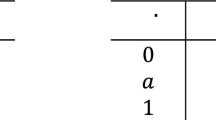Abstract
The notion of falling fuzzy \(h\)-interior ideals of a hemiring is introduced and some related properties are investigated. A special attention is given to two kinds of certain and impossible probability spaces. Finally, we investigate some characterizations of \(h\)-semisimple and \(h\)-quasi-hemiregular hemirings based on independent (perfect positive correlation) probability spaces.
Similar content being viewed by others
Explore related subjects
Discover the latest articles, news and stories from top researchers in related subjects.References
Aho AW, Ullman JD (1979) Introduction to automata theory, language and computation. Addison-Wesley, Reading, MA
Akram M, Dudek WA (2008) Intuitionistic fuzzy \(k\)-ideals of semirings. Soft Comput 12(5):881–890
Chen J, Suarez J, Molnar P, Behal A (2011) Maximum likelihood parameter estimation in a stochastic resonate-and-fire neuronal model. In: Computational advances in bio and medical sciences (ICCABS), 2011 IEEE 1st international conference, pp 57–62.
Dudek WA, Shabir M, Anjum R (2012) Characterizations of hemirings by their \(h\)-ideals. Comput Math Appl 59:3167–3179
Dudek WA (2008) Special types of intuitionistic fuzzy left \(h\)-ideals of hemirings. Soft Comput 12(4):359–364
Dudek WA, Shabir M, Anjum R (2010) Characterizations of hemirings by their \(h\)-ideals. Comput Math Appl 59(9):3167–3179
Goodman IR (1982) Fuzzy sets as equivalence classes of random sets. In: Yager R (ed) Recent developments in fuzzy sets and possibility theory. Pergamon, New York
Golan JS (1999) Semirings and their applications. Kluwer Academic Publishers, Dordrecht
Henriksen M (1958) Ideals in semirings with commutative addition. Am Math Soc Not 6:321
Hopcroft JE (2008) Introduction to automata theory, languages, and computation. Pearson Education India
Jun YB, \(\ddot{O}\)zt\(\ddot{u}\)rk MA, Song SZ (2004) On fuzzy \(h\)-ideals in hemirings. Inform Sci 162:211–226
Jun YB (2010) Note on \((\alpha, \beta )\)-fuzzy ideals of hemirings. Comput Math Appl 59:2582–2586
Jun YB, Kim HS, \(\ddot{O}\)zt\(\ddot{u}\)rk MA (2005) Fuzzy \(k\)-ideals in semirings. J Fuzzy Math 13:351–364
Kuich W, Salomaa A (1985) Semirings, automata, languages. Springer, Secaucus
Iizuka K (1959) On the jacobson radical of a semiring. Tohoku Math J 11(2):409–421
La Torre DR (1965) On \(h\)-ideals and \(k\)-ideals in hemirings. Publ Math Debr 12(2):219–226
Ma X, Zhan J (2007) On fuzzy \(h\)-ideals of hemirings. J Syst Sci Complex 20(3):470–478
Ma X, Yin Y, Zhan J (2012) Characterizations of \(h\)-intra- and \(h\)-quasi-hemiregular hemirings. Comput Math Appl 63(4):783–793
Ma X, Zhan J (2009) Generalized fuzzy \(h\)-bi-ideals and \(h\)-quasi-ideals of hemirings. Inform Sci 179:1249–1268
Sardar SK, Manda D, Davvaz B (2012) Fuzzy \(h\)-ideal of matrix hemiring \({S_2} = \left( \begin{array}{l} R\;\;\;\Gamma \\ S\;\;\;S \end{array} \right)\). Iran J Fuzzy syst 9:55–70
Tan SK, Wang PZ, Lee ES (1993) Fuzzy set operations based on the theory of falling shadows. J Math Anal Appl 174:242–255
Tan SK, Wang PZ, Zhang XZ (1993) Fuzzy inference relation based on the theory of falling shadows. Fuzzy Sets Syst 53:179–188
La Torre DR (1965) On \(h\)-ideals and \(k\)-ideals in hemirings. Publ Math Debr 12:219–226
Vandiver HS (1934) Note on a simple type of algebra in which cancellation law of addition does not hold. Bull Am Math Soc 40:914–920
Wang PZ, Sanchez E (1982) Treating a fuzzy subset as a projectable random set. In: Gupta MM, Sanchez E (eds) Fuzzy Inform Decis. Pergamon, New York, pp 212–219
Yin Y, Li HX (2008) The characterizatins of \(h\)-hemiregular hemirings and \(h\)-\(intra\)-hemiregular hemirings. Inform Sci 178:3451–3464
Yin Y, Huang X, Xu D, Li H (2009) The characterization of \(h\)-semisimple hemirings. Int J Fuzzy Syst 11:116–122
Yuan XH, Lee ES (1997) A fuzzy system based on the theory of falling shadows. J Math Anal Appl 208:243–251
Yu B, Zhan J (2013a) Falling fuzzy ideals of hemirings. J Intell Fuzzy Syst 25:1037–1042
Yu B, Zhan J (2013b) Characterizations of hemirings based on probability spaces. J Appl Math. 2013:1–9. Article ID 716435
Yu B, Zhan J (2015) Applications of falling fuzzy \(h\)-bi-(\(h\)-quasi-)ideals to hemirings based on probability spaces. J Mult-valued Logic Soft Comput (in press)
Zadeh LA (1965) Fuzzy sets. Inform Control 8:338–353
Zhan J, Dudek WA (2007) Fuzzy \(h\)-ideals of hemirings. Inform Sci 117(3):876–886
Zhan J, Yin Y (2012) A new view of fuzzy \(k\)-ideals of hemirings. J Intell Fuzzy Syst 23:169–176
Zhi L, Chen J, Molnar P, Behal A (2012) Weighted least-squares approach for identification of a reduced-order adaptive neuronal model. Neural Netw Learn Syst 23:834–840
Acknowledgments
The authors are very grateful to referees for their valuable comments and suggestions for improving this paper. This research is partially supported by a grant of National Natural Science Foundation of China (11461025).
Author information
Authors and Affiliations
Corresponding author
Additional information
Communicated by V. Loia.
Rights and permissions
About this article
Cite this article
Zhan, J., Yu, B. & Fotea, VE. Characterizations of two kinds of hemirings based on probability spaces. Soft Comput 20, 637–648 (2016). https://doi.org/10.1007/s00500-014-1528-x
Published:
Issue Date:
DOI: https://doi.org/10.1007/s00500-014-1528-x




